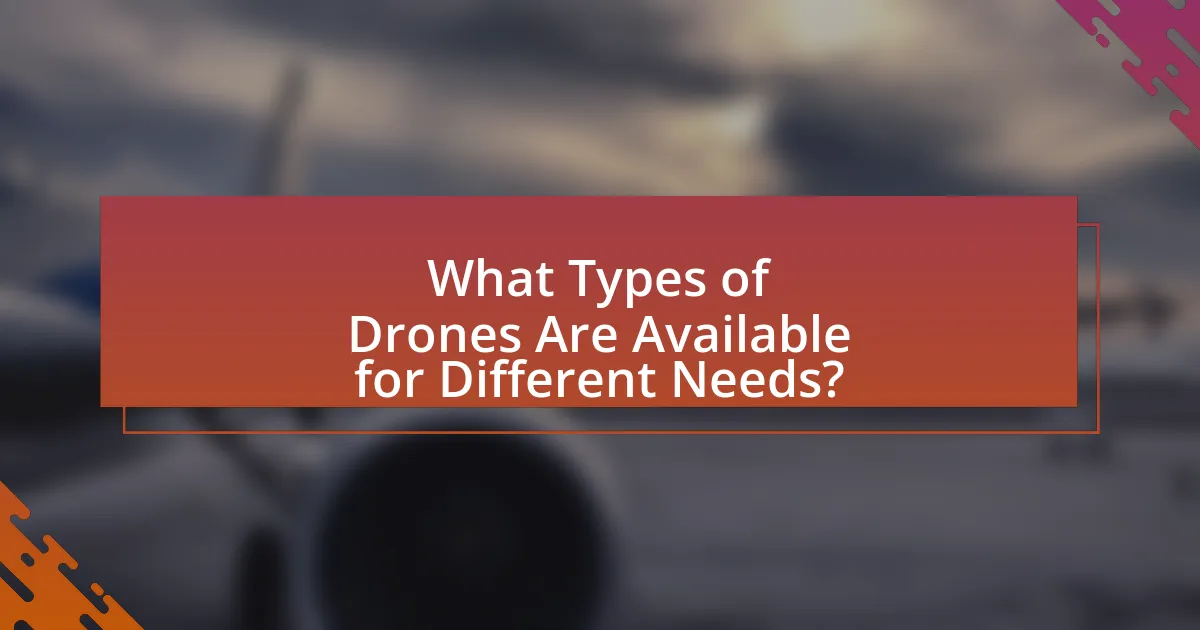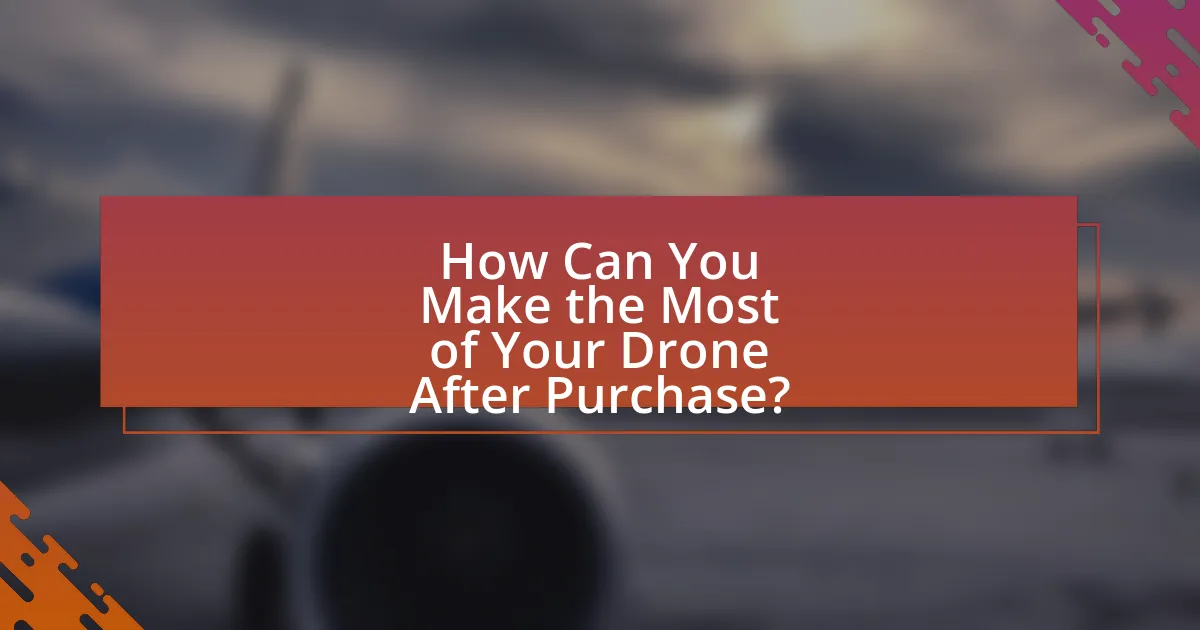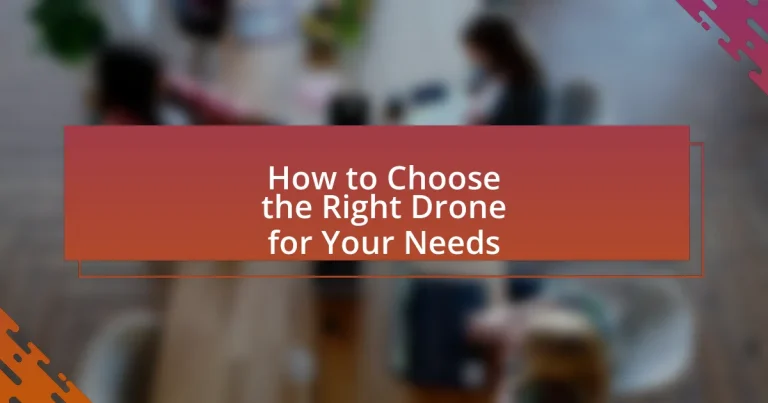The article focuses on how to choose the right drone based on individual needs and preferences. It outlines essential factors to consider, including the purpose of use, flight time, camera quality, range, and budget. The article also discusses the impact of intended tasks and environmental conditions on drone selection, as well as key specifications to look for, such as payload capacity and GPS capabilities. Additionally, it highlights the importance of understanding legal regulations, maintenance practices, and techniques for improving flying and photography skills, providing a comprehensive guide for potential drone users.

What Factors Should You Consider When Choosing a Drone?
When choosing a drone, consider factors such as purpose, flight time, camera quality, range, and budget. The purpose determines the type of drone needed; for example, recreational drones differ from professional photography drones. Flight time typically ranges from 20 to 30 minutes for consumer models, impacting usability for extended tasks. Camera quality is crucial for aerial photography, with resolutions varying from 720p to 4K, affecting image clarity. Range, which can extend from a few hundred meters to several kilometers, influences operational flexibility. Lastly, budget constraints dictate the features and quality of the drone, with prices ranging from under $100 to several thousand dollars for high-end models.
How do your intended uses influence your drone choice?
Intended uses significantly influence drone choice by determining the required specifications and features. For instance, if the primary use is aerial photography, a drone with a high-resolution camera and stable gimbal is essential. Conversely, for agricultural monitoring, a drone equipped with multispectral sensors is necessary to assess crop health. Additionally, the intended use affects factors such as flight time, payload capacity, and range; for example, drones used for surveying need longer flight times and greater range to cover extensive areas. These specifications align with industry standards, such as the FAA’s guidelines for commercial drone operations, which emphasize the importance of matching drone capabilities to specific operational needs.
What specific tasks do you plan to accomplish with a drone?
I plan to accomplish aerial photography and videography with a drone. This task allows for capturing high-quality images and videos from unique perspectives, which is essential for various applications such as real estate marketing, event documentation, and landscape photography. According to a study by the Association for Unmanned Vehicle Systems International, the use of drones in photography has increased by over 70% in the past five years, demonstrating their growing importance in visual media.
How does the environment affect your drone selection?
The environment significantly influences drone selection by dictating the required specifications and features for optimal performance. For instance, flying in urban areas necessitates drones with advanced obstacle avoidance systems due to the presence of buildings and other structures, while rural or open environments may allow for simpler models. Additionally, weather conditions such as wind speed and precipitation levels impact battery life and stability; drones designed for high winds typically feature robust construction and powerful motors. Research indicates that drones used in coastal areas must also be resistant to saltwater corrosion, highlighting the need for material considerations based on environmental factors. Thus, understanding the specific environmental conditions where the drone will operate is crucial for making an informed selection.
What are the key specifications to look for in a drone?
The key specifications to look for in a drone include flight time, camera quality, range, payload capacity, and GPS capabilities. Flight time typically ranges from 20 to 30 minutes for consumer drones, impacting how long you can operate before needing a recharge. Camera quality is crucial, with resolutions often ranging from 1080p to 4K, affecting the clarity of images and videos captured. Range refers to the maximum distance the drone can operate from the controller, which can vary from a few hundred meters to several kilometers. Payload capacity is important for carrying additional equipment, such as cameras or sensors, and can range from a few hundred grams to several kilograms. GPS capabilities enhance navigation and stability, allowing for features like return-to-home and waypoint navigation. These specifications collectively determine the drone’s performance and suitability for specific tasks.
How does camera quality impact your drone experience?
Camera quality significantly enhances the drone experience by determining the clarity and detail of aerial imagery. High-resolution cameras capture sharper images and videos, allowing users to document landscapes, events, or inspections with greater fidelity. For instance, drones equipped with 4K cameras provide four times the resolution of 1080p cameras, resulting in more vibrant and detailed footage. Additionally, advanced camera features such as optical zoom and stabilization improve the overall quality of the captured content, making it more suitable for professional use in fields like photography and videography. Therefore, the camera quality directly influences the usability and satisfaction derived from drone operations.
What flight time and range should you expect from a drone?
Drones typically have a flight time ranging from 20 to 40 minutes, depending on the model and battery capacity. For example, consumer drones like the DJI Mavic Air 2 can achieve around 34 minutes of flight time, while racing drones may have shorter durations due to higher power demands. The range of drones varies significantly, with many consumer models offering a control range of 1 to 7 kilometers. For instance, the DJI Mini 2 has a maximum range of 10 kilometers, showcasing the advancements in drone technology. These specifications are crucial for users to consider when selecting a drone that meets their operational needs.
Why is budget an important consideration when selecting a drone?
Budget is an important consideration when selecting a drone because it directly influences the quality, features, and capabilities of the drone. Higher-priced drones typically offer advanced technology, better camera quality, longer flight times, and enhanced durability, which can significantly impact performance and user experience. For instance, consumer drones can range from $100 to over $2,000, with professional-grade models often exceeding this range. A study by the Consumer Technology Association indicates that consumers are willing to invest more in drones that provide superior functionality and reliability, highlighting the correlation between budget and drone performance. Thus, understanding one’s budget helps in making informed decisions that align with specific needs and intended use.
What are the price ranges for different types of drones?
The price ranges for different types of drones vary significantly based on their features and intended use. Consumer drones typically range from $100 to $1,500, while professional drones can cost between $1,500 and $10,000. High-end commercial drones, often used for specialized applications like surveying or filmmaking, can exceed $10,000. These price ranges reflect the varying capabilities, such as camera quality, flight time, and additional functionalities, which are essential for different user needs.
How can you balance features and cost effectively?
To balance features and cost effectively when choosing a drone, prioritize essential features that align with your specific needs while comparing prices across different models. For instance, if high-resolution photography is crucial, focus on drones that offer this capability without unnecessary extras, such as advanced obstacle avoidance systems that may increase costs. Research indicates that consumers can save up to 30% by selecting models that meet their primary requirements rather than opting for high-end models with features they may not use. This approach ensures that you invest in a drone that provides the best value for your intended use, maximizing functionality while minimizing unnecessary expenditure.

What Types of Drones Are Available for Different Needs?
There are several types of drones available to meet different needs, including consumer drones, commercial drones, racing drones, and specialized drones. Consumer drones are designed for recreational use, often equipped with cameras for photography and videography. Commercial drones serve various industries, such as agriculture, construction, and delivery services, featuring advanced sensors and payload capabilities. Racing drones are built for speed and agility, used in competitive racing events. Specialized drones, such as surveying drones or search and rescue drones, are tailored for specific tasks, often incorporating unique technology to enhance their functionality. Each type of drone is designed to address particular requirements, making it essential to choose one based on the intended application.
What are the main categories of drones?
The main categories of drones are consumer drones, commercial drones, and military drones. Consumer drones are typically used for recreational purposes, such as photography and racing, and are widely available to the public. Commercial drones are utilized in various industries, including agriculture, construction, and delivery services, often equipped with specialized technology for specific tasks. Military drones are designed for defense and surveillance operations, featuring advanced capabilities for reconnaissance and combat. These categories reflect the diverse applications and functionalities of drones in different sectors.
How do consumer drones differ from professional drones?
Consumer drones are designed for recreational use and typically feature simpler controls, lower price points, and limited camera capabilities, while professional drones are built for commercial applications, offering advanced features, higher durability, and superior imaging technology. For instance, consumer drones often have flight times of around 20-30 minutes and basic stabilization, whereas professional drones can achieve flight times exceeding 30 minutes and include advanced features like 4K video recording and obstacle avoidance systems. This distinction is evident in the specifications of popular models, such as the DJI Mavic Mini for consumers and the DJI Matrice series for professionals, which cater to different user needs and operational requirements.
What are the advantages of racing drones versus photography drones?
Racing drones offer superior speed and agility compared to photography drones, making them ideal for competitive racing and fast-paced maneuvers. Racing drones are designed for high-performance, featuring lightweight frames and powerful motors that enable rapid acceleration and quick turns. In contrast, photography drones prioritize stability and camera quality, which can limit their speed and maneuverability. For instance, racing drones can reach speeds exceeding 100 miles per hour, while photography drones typically operate at slower speeds to ensure stable imaging. This performance advantage allows racing drones to navigate complex courses and obstacles effectively, which is essential in racing environments.
Which drone models are best for beginners?
The best drone models for beginners include the DJI Mini SE, Holy Stone HS720, and Potensic D80. The DJI Mini SE is lightweight, easy to fly, and offers a 30-minute flight time, making it ideal for novices. The Holy Stone HS720 features GPS-assisted flight and a 4K camera, providing stability and quality for new users. The Potensic D80 is equipped with a 1080P HD camera and has user-friendly controls, making it accessible for those just starting. These models are recognized for their ease of use, safety features, and affordability, which are essential for beginner pilots.
What features should beginner drones have for ease of use?
Beginner drones should have features such as user-friendly controls, stable flight capabilities, and built-in safety mechanisms for ease of use. User-friendly controls, including one-button takeoff and landing, simplify operation for novices. Stable flight capabilities, often achieved through GPS assistance and altitude hold functions, help maintain control and reduce crashes. Built-in safety mechanisms, like automatic return-to-home and obstacle avoidance, enhance safety and confidence for new users. These features collectively ensure that beginners can operate drones with minimal frustration and a lower risk of accidents.
How can you find reliable reviews for beginner drones?
To find reliable reviews for beginner drones, consult reputable technology websites and forums that specialize in drone reviews. Websites like CNET, TechRadar, and DroneDJ provide expert evaluations and user feedback, ensuring a comprehensive understanding of various models. Additionally, platforms such as Amazon and Best Buy feature customer reviews that can highlight real-world experiences, helping to gauge the performance and reliability of beginner drones. These sources are known for their credibility and thoroughness in reviewing consumer electronics, making them valuable for informed decision-making.
What are the legal considerations when choosing a drone?
When choosing a drone, legal considerations include compliance with local regulations, registration requirements, and airspace restrictions. In many countries, such as the United States, the Federal Aviation Administration (FAA) mandates that drones over a certain weight must be registered before use. Additionally, operators must adhere to specific operational guidelines, including maintaining visual line-of-sight and avoiding restricted airspace, such as near airports or military installations. Violating these regulations can result in fines or legal action, underscoring the importance of understanding and following the applicable laws in your area.
What regulations should you be aware of in your area?
You should be aware of local drone regulations that govern flight altitude, no-fly zones, and registration requirements. In many areas, regulations stipulate that drones must not exceed a flight altitude of 400 feet and must avoid flying near airports, schools, and populated areas. Additionally, the Federal Aviation Administration (FAA) in the United States requires drone operators to register their drones if they weigh more than 0.55 pounds. Compliance with these regulations is essential to ensure safety and avoid legal penalties.
How can you ensure compliance with drone laws?
To ensure compliance with drone laws, operators must familiarize themselves with local regulations and obtain necessary permits. This involves researching the Federal Aviation Administration (FAA) guidelines in the United States, which require registration of drones over a certain weight and adherence to specific operational rules, such as maintaining visual line of sight and avoiding restricted airspace. Additionally, operators should stay updated on any changes in legislation, as drone laws can evolve rapidly. Compliance can be further ensured by participating in training programs and obtaining certifications, such as the FAA’s Part 107 Remote Pilot Certificate, which demonstrates knowledge of regulations and safe flying practices.

How Can You Make the Most of Your Drone After Purchase?
To make the most of your drone after purchase, familiarize yourself with its features and capabilities through the user manual and online tutorials. Understanding the specific functionalities, such as camera settings, flight modes, and battery management, enhances your operational efficiency. For instance, practicing in open areas helps improve your piloting skills and confidence, while utilizing software updates ensures optimal performance and access to new features. Engaging with online communities or forums can provide valuable tips and troubleshooting advice, further enhancing your experience.
What are the best practices for drone maintenance?
The best practices for drone maintenance include regular inspections, timely firmware updates, and proper storage. Regular inspections involve checking the drone’s physical components, such as propellers, motors, and batteries, for wear and damage, which helps prevent malfunctions during flight. Timely firmware updates ensure that the drone operates with the latest features and security patches, enhancing performance and safety. Proper storage, including keeping the drone in a dry, cool place and removing batteries when not in use, extends the lifespan of both the drone and its components. These practices are supported by industry guidelines from organizations like the Federal Aviation Administration (FAA), which emphasize the importance of maintenance for safe drone operation.
How often should you inspect and maintain your drone?
You should inspect and maintain your drone before each flight and perform a thorough check after every 10 flights or at least once a month. Regular inspections help identify potential issues such as battery health, propeller condition, and firmware updates, which are crucial for safe operation. According to the Federal Aviation Administration (FAA), routine maintenance and inspections are essential for ensuring the reliability and safety of unmanned aircraft systems.
What common issues should you troubleshoot regularly?
Common issues to troubleshoot regularly with drones include battery performance, connectivity problems, and firmware updates. Battery performance can degrade over time, affecting flight time and reliability; monitoring battery health is essential for optimal operation. Connectivity issues, such as loss of signal or interference, can disrupt control and navigation, necessitating regular checks of the remote control and drone settings. Lastly, firmware updates are crucial for maintaining functionality and security, as manufacturers often release updates to fix bugs and improve performance. Regularly addressing these issues ensures safe and efficient drone operation.
How can you enhance your flying skills with practice?
To enhance your flying skills with practice, consistently engage in controlled flying sessions that focus on specific maneuvers. Practicing basic movements such as takeoffs, landings, and turns in various conditions improves coordination and control. Research indicates that pilots who dedicate time to repetitive practice of these fundamental skills experience a 30% increase in proficiency over a three-month period. Additionally, utilizing simulators can provide a risk-free environment to refine techniques before applying them in real-world scenarios.
What training resources are available for new drone pilots?
New drone pilots can access various training resources, including online courses, instructional videos, and hands-on workshops. Online platforms like Udemy and Coursera offer structured courses that cover drone operation, regulations, and safety protocols. Additionally, the Federal Aviation Administration (FAA) provides free resources, including the “Pilot’s Handbook of Aeronautical Knowledge,” which is essential for understanding the principles of flight and drone regulations. Local flying clubs and organizations often host workshops and training sessions, allowing new pilots to gain practical experience under the guidance of experienced instructors. These resources collectively ensure that new drone pilots receive comprehensive training to operate their drones safely and effectively.
How can you join a community of drone enthusiasts for support?
To join a community of drone enthusiasts for support, you can participate in online forums, social media groups, and local meetups dedicated to drone flying and technology. Websites like Reddit, Facebook, and specialized drone forums such as DJI Forum or DronePilots provide platforms for interaction, sharing experiences, and seeking advice. Additionally, attending local drone events or clubs can facilitate face-to-face connections with fellow enthusiasts, enhancing your support network. Engaging in these communities allows you to access a wealth of knowledge and resources, as many members share tips, troubleshooting advice, and recommendations based on their experiences.
What tips can help you capture better aerial footage?
To capture better aerial footage, ensure you use a drone equipped with a high-quality camera and stabilization technology. High-resolution cameras, such as those with 4K capabilities, provide clearer images, while gimbal stabilization minimizes shaky footage, resulting in smoother videos. Additionally, consider the time of day for shooting; golden hour, shortly after sunrise or before sunset, offers optimal lighting conditions that enhance the visual quality of your footage. Furthermore, plan your shots by scouting locations and considering angles that highlight the landscape effectively. Lastly, practice flying your drone in various conditions to improve your piloting skills, which directly impacts the quality of the footage captured.
How can you utilize different camera settings for optimal results?
To utilize different camera settings for optimal results, adjust the aperture, shutter speed, and ISO based on the shooting environment. The aperture controls the amount of light entering the lens, affecting depth of field; a wider aperture (lower f-stop number) creates a blurred background, ideal for portraits, while a narrower aperture (higher f-stop number) keeps more of the scene in focus, suitable for landscapes. Shutter speed determines how long the camera sensor is exposed to light; faster speeds freeze motion, while slower speeds capture motion blur, enhancing dynamic scenes. ISO sensitivity affects the camera’s ability to capture light; a lower ISO (100-400) is best for bright conditions, while a higher ISO (800 and above) is useful in low light but may introduce noise. These settings work together to achieve the desired exposure and artistic effect, ensuring high-quality images in various conditions.
What techniques can improve your drone photography skills?
To improve your drone photography skills, practice using manual camera settings to gain better control over exposure, shutter speed, and ISO. Mastering these settings allows photographers to adapt to varying lighting conditions and achieve desired effects. Additionally, utilizing composition techniques such as the rule of thirds and leading lines enhances visual interest in images. Research indicates that well-composed photographs are more engaging, as supported by studies on visual perception. Regularly reviewing and analyzing your work can also identify areas for improvement, leading to more refined skills over time.



